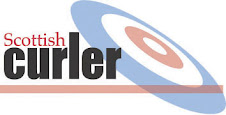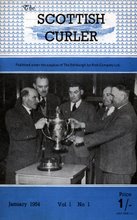 The Royal Caledonian Curling Club owns a large oil painting by Charles Lees of the Grand Match at Linlithgow Loch. This took place on January 25, 1848. Thirty-five northern rinks played an equal number of southern rinks, with a further hundred southern rinks playing matches amongst themselves. Including spectators, some six thousand persons were present. The painting is not an accurate representation of the day, it being a composite portrait of all the curling notables of Scotland, Lees using artistic licence to include them as if they had been there. There is evidence to suggest that Lees travelled to the homes of curlers to sketch them, so that their likenesses could be accurately included in the large painting which was completed in 1849. The painting shows clearly the curlers’ dress and the single soled stones which were in use at the time. The painting was purchased by the Royal Club following a decision taken at the AGM in July, 1898.
The Royal Caledonian Curling Club owns a large oil painting by Charles Lees of the Grand Match at Linlithgow Loch. This took place on January 25, 1848. Thirty-five northern rinks played an equal number of southern rinks, with a further hundred southern rinks playing matches amongst themselves. Including spectators, some six thousand persons were present. The painting is not an accurate representation of the day, it being a composite portrait of all the curling notables of Scotland, Lees using artistic licence to include them as if they had been there. There is evidence to suggest that Lees travelled to the homes of curlers to sketch them, so that their likenesses could be accurately included in the large painting which was completed in 1849. The painting shows clearly the curlers’ dress and the single soled stones which were in use at the time. The painting was purchased by the Royal Club following a decision taken at the AGM in July, 1898.I first saw the painting in the early 1960s when it hung at the old Perth rink. It fascinated me then, and continues to do so. Lees is well known for 'The Golfers' which was purchased by the National Galleries of Scotland in 2002 and is on display in Edinburgh. A photo of Charles Lees is here.
One year ago in 2006 the Royal Club asked auction house Sotheby's to value Lees's Grand Match painting so it would know what insurance cover to provide. There was good news, and bad news for Royal Club members.
The good news was that the painting was now worth a substantial sum of money, potentially in excess of £500,000. The bad news was that it needed renovation and when repaired it would be very expensive to insure.
Sotheby’s was instructed to assess interest in the painting from their private client list with the option to go to an auction sale in autumn 2007.
Meanwhile the RCCC Board of Directors sought the opinion of members about what to do with the painting. The Board believed that there were only three options:
1. Keep the painting but do not restore it
2. Keep the painting and restore it
3. Sell the painting
There were other options of course, such as simply giving it, or loaning it, to the National Galleries of Scotland, but these were not canvassed.
 Option 3 received the most support, although concern was expressed that if the painting went to an open auction it might well be bought by a private buyer and disappear abroad, never to be on view in Scotland again. This concern was heeded by the RCCC Board and by February it seemed that the future of the painting had been secured. Sotheby's was instructed to continue as the selling agent but negotiations were to be with the National Galleries of Scotland only!
Option 3 received the most support, although concern was expressed that if the painting went to an open auction it might well be bought by a private buyer and disappear abroad, never to be on view in Scotland again. This concern was heeded by the RCCC Board and by February it seemed that the future of the painting had been secured. Sotheby's was instructed to continue as the selling agent but negotiations were to be with the National Galleries of Scotland only!Four months later these two parties are still in discussion. Sotheby's, quite naturally, will want to sell the painting for as large a sum as possible to maximise the percentage fee they will receive. The National Galleries of Scotland, quite naturally, will want to pay as little as possible for the painting.
It is a strange arrangement. The Royal Club Board wants Sotheby's to sell the painting and at the same time it wants the National Galleries of Scotland to purchase it. But both seller's agent and the prospective purchaser clearly have their own, very different, interests.
Where does that leave us, the curlers of Scotland to whom the painting belongs? We are represented by the Royal Club Directors, who appear to be standing back from the discussions. Will they step in if the negotiations reach a stalemate?
The most recent 'negotiating tactic' by the National Galleries has been the production of a report which apparently states that the cost of repairing the painting will be much more than at first thought (the detail of this report is confidential, according to RCCC CEO Colin Grahamslaw). However at the recent RCCC AGM it was stated that if the sale does go ahead it will be a year before the painting is again on display.
Colin says that 'it may be another month or so' before we learn the outcome of the negotiations. Call me a pessimist if you like but I suspect this story has a long way yet to run!
The reproduction of Lees's painting is from David B Smith's book Curling: An Illustrated History. The detail of the original painting is from the Scottish Curler archive.


No comments:
Post a Comment